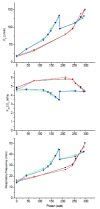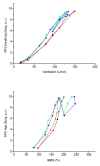Control and sensation of breathing during cycling exercise in hypoxia under naloxone: a randomised controlled crossover trial
- PMID: 23849512
- PMCID: PMC3710144
- DOI: 10.1186/2046-7648-2-1
Control and sensation of breathing during cycling exercise in hypoxia under naloxone: a randomised controlled crossover trial
Abstract
Background: Opioid receptors are possibly involved in the perception of exertion and the ventilatory response to exercise. We compared incremental cycling exercise in conditions of normoxia and hypoxia (11% O2) after injection of the opioid receptor antagonist naloxone (30 mg i.v.) or placebo. Naloxone was expected to increase sensation of breathing and cycling and to curtail exercise performance more in hypoxia.
Methods: Ten healthy subjects (29 ± 2 years, 183 ± 6 cm, 75 ± 7 kg, mean ± SD) cycled in normoxia and hypoxia until voluntary exhaustion, receiving naloxone or placebo in a balanced double-blind crossover design.
Results: Hypoxia decreased peak power output by 37%-39% with placebo and naloxone (P < 0.001, no effect of naloxone). Switching to normoxia at exhaustion in hypoxia allowed continuing up to 97%-100% of power developed in normoxia with placebo and naloxone (P < 0.001, no effect of naloxone). Perceived exertion increased in hypoxia, dropped upon switching to normoxia and increased again towards exhaustion, no effect of naloxone. SpO2 (earlobe oximetry) was lower in hypoxia, dropping to 64%-68% with naloxone and placebo. The ventilatory response to exercise in normoxia and hypoxia was not changed by naloxone.
Conclusions: It follows that in healthy subjects the ventilatory response and the perception of exertion in hypoxia as compared to normoxia do not involve the endogenous opioid system, and the latter does not play a role in limiting maximum exercise capacity in hypoxia.
Figures




Similar articles
-
Effect of naloxone on perceived exertion and exercise capacity during maximal cycle ergometry.J Appl Physiol (1985). 2002 Dec;93(6):2023-8. doi: 10.1152/japplphysiol.00521.2002. Epub 2002 Aug 23. J Appl Physiol (1985). 2002. PMID: 12391054 Clinical Trial.
-
Effect of naloxone on maximal exercise performance and control of ventilation in COPD.Chest. 1989 Oct;96(4):761-6. doi: 10.1378/chest.96.4.761. Chest. 1989. PMID: 2676390 Clinical Trial.
-
Influence of Inspiratory Muscle Training on Ventilatory Efficiency and Cycling Performance in Normoxia and Hypoxia.Front Physiol. 2017 Mar 8;8:133. doi: 10.3389/fphys.2017.00133. eCollection 2017. Front Physiol. 2017. PMID: 28337149 Free PMC article.
-
Acute Beetroot Juice Supplementation Does Not Improve Cycling Performance in Normoxia or Moderate Hypoxia.Int J Sport Nutr Exerc Metab. 2015 Aug;25(4):359-66. doi: 10.1123/ijsnem.2014-0129. Epub 2015 Mar 26. Int J Sport Nutr Exerc Metab. 2015. PMID: 25811674 Clinical Trial.
-
Ensemble Input of Group III/IV Muscle Afferents to CNS: A Limiting Factor of Central Motor Drive During Endurance Exercise from Normoxia to Moderate Hypoxia.Adv Exp Med Biol. 2016;903:325-42. doi: 10.1007/978-1-4899-7678-9_22. Adv Exp Med Biol. 2016. PMID: 27343106 Review.
Cited by
-
The human ventilatory response to stress: rate or depth?J Physiol. 2017 Sep 1;595(17):5729-5752. doi: 10.1113/JP274596. Epub 2017 Jul 27. J Physiol. 2017. PMID: 28650070 Free PMC article. Review.
-
Cerebral oxygenation during the Richalet hypoxia sensitivity test and cycling time-trial performance in severe hypoxia.Eur J Appl Physiol. 2014 May;114(5):1037-48. doi: 10.1007/s00421-014-2835-8. Epub 2014 Feb 9. Eur J Appl Physiol. 2014. PMID: 24509979
-
The Importance of Respiratory Rate Monitoring: From Healthcare to Sport and Exercise.Sensors (Basel). 2020 Nov 9;20(21):6396. doi: 10.3390/s20216396. Sensors (Basel). 2020. PMID: 33182463 Free PMC article. Review.
-
Respiratory Frequency during Exercise: The Neglected Physiological Measure.Front Physiol. 2017 Dec 11;8:922. doi: 10.3389/fphys.2017.00922. eCollection 2017. Front Physiol. 2017. PMID: 29321742 Free PMC article.
References
-
- Borg E, Borg G, Larsson K, Letzter M, Sundblad B-M. An index for breathlessness and leg fatigue. Scand J Med Sci Sports. 2010;20:644–650. - PubMed
-
- Parshall MB, Schwartzstein RM, Adams L, Banzett RB, Manning HL, Bourbeau J, Calverley PM, Gift AG, Harver A, Lareau SC, Mahler DA, Meek PM, O'Donnell DE. ATS Committee on Dyspnea. An official American Thoracic Society statement: update on the mechanisms, assessment, and management of dyspnea. Am J Resp Crit Care. 2012;185:435–452. doi: 10.1164/rccm.201111-2042ST. - DOI - PMC - PubMed
LinkOut - more resources
Full Text Sources
Other Literature Sources

